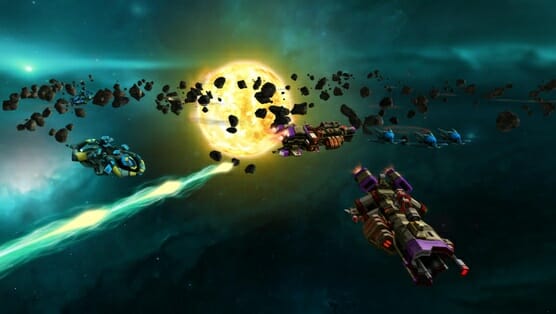Sid Meier’s Starships: Fighting Gravity

I can’t think about Sid Meier’s Starships, Firaxis Games’ latest game of sci-fi strategy and tactics, without thinking of the modern myth of planetary escape.
The myth normally goes like this: Things on our home planet get bad. Really bad. Thankfully for us, we’re not stuck here. The universe is massive and it is ours to conquer. “We’re not meant to save the world,” says Professor John Brand (Michael Caine) in Interstellar, “We’re meant to leave it.” Brand echoes dozens of other futurists, real and fictional. He’s Ray Kurzweil, with his dream of interstellar transhumanism. He’s Mobile Suit Gundam’s Zeon Zum Deikun, with his philosophy of “spacenoid” supremacy. He’s Zefram Cochrane, inventor of the warp drive in Star Trek: First Contact. He’s the Mars One program. And he is, of course, the science victory in Firaxis’ Sid Meier’s Civilization series: Build the space ship, set off into the stars, and leave the soil behind.
The problem with this myth is that it promises us that in leaving Earth, we’ll escape our problems, too. And hey, don’t worry, the way to the stars is to double down on industry, technology, and (in our contemporary moment) the private sector. It is an empty ideology that assures us that if we just stay the course, we’ll be fine. Even if that means ignoring real, material problems. Even if that means destroying our home in the process.
What makes Firaxis’ (and Meier’s) output so interesting is that they aren’t content to leave the “escape to the stars” myth alone. With 1999’s Alpha Centauri and last year’s Civilization: Beyond Earth, they complicate (and ground, literally) the happy ending of that story by reminding us that wherever we find ourselves in this vast galaxy, there will still be conflict, scarcity and struggle. There may be Beyond Earth, but there’s no beyond history.
Sid Meier’s Starships takes a different route in subverting this myth. In Starships, you play as a society that has chosen to deal with its earthly (or Canis Majoris 39-ly) problems instead of fleeing from them. It’s only when scientists receive and decode a galactic cry for help that your civilization turns to the stars, eager to aid those in need. If Beyond Earth argues that we’ll find conflict no matter where we’ll go, Starships argues that on a long enough timeline, conflict will find us (and disrupt our utopia in the process.)
How to Win Battles and Influence Planets
In Starships, that conflict centers around who controls the galaxy’s resources. Starships keeps things abstract: “Energy” and “Science” are used to build and upgrade your ships; “Food” pays for new cities; “Metals” let you develop game-changing Wonders and other planetary improvements. Getting access to these resources leads to victory, and as in Civilization, victory can come in a handful of forms: Control 51% of the galactic population, eliminate every other opponent from the map, fully develop three of the nine available technological research paths, or develop seven “Wonders.” Whichever path you pursue, each victory condition revolves around the accumulation of these resources. The same could be said for Civilization, of course, but three major things differentiate Starships from its earthly predecessors.
First, these resources are not simply strewn around, ready and waiting for your manifest destiny to lead you to them. Instead: they exist on already-inhabited planets, spread as nodes across a galactic map, with the occasional asteroid field or empty space sector to break them up. But you aren’t out to conquer these worlds—not exactly. Instead, you (and your opponents, the other starfaring races of the galaxy) compete for the attention, loyalty and resources of these planets.
If you’re first to find a planet, you get a point of influence, and you gain the ability to see every adjacent star sector. If you help that same planet out by defeating a local band of space pirates or bringing a rogue space station under control, take another point, and begin to receive 50% of that planet’s resource production. You could buy a third point with credits, at which point you’d receive 100% of those resources. And if you end a turn while parked on a planet, gain another influence point. If that’s your fourth point, then the planet enters into the player’s federation, letting you develop its latent Wonder and defend it with your military power.
That military power is the second major difference from Civilization, or even from other space-based games in the 4X genre. While these other games put you in charge of a bunch of different military units, each able to explore and battle on their own, in Starships you command only a single military unit. That unit starts as a small fleet of two ships, but can increase to an armada of eight (each of which could itself house up to eight fighter units). You slide this single fleet across the map like a board game piece, hopping from node to node, picking up influence and resources, and engaging in combat missions.
Combat in Starships occurs on a separate map that represents the space immediately around each planet. You individually move each ship in your fleet and then perform one action with it (like attacking, cloaking or launching fighters), before handing control over to your opponent once you’ve finished with each of your ships. Each of these ships is composed of nine “modules”—engines, shields, armor, lasers, cannons, stealth, sensors, and fighters. Starships uses these to evoke every old trope of the naval-style of sci-fi space combat, and in the process it produces tactical battles that are accessible and fun. Ships have strong shields in the front, and are weaker on the side and rear. Heavy armor slows things down and massive engines speed things back up. A torpedo cuts across the dark over multiple turns, dividing your fleet in half as they flee from its explosive payload. Ships snipe at each other with long range lasers, and devastate each other with short range plasma cannons. Cloaking is countered through actively searching the area with your scanners, or through proximity (but by then, it’s probably too late). It all makes sense because you’ve seen it all before. This is a good thing.
-

-

-

-

-

-

-

-

-

-

-

-

-

-

-

-

-

-

-

-

-

-

-

-

-

-

-

-

-

-

-

-

-

-

-

-

-

-

-

-









































